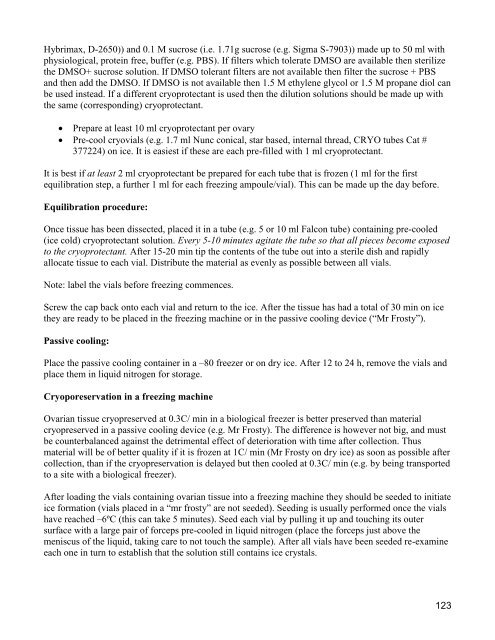Resource Manual - International Embryo Transfer Society
Resource Manual - International Embryo Transfer Society
Resource Manual - International Embryo Transfer Society
Create successful ePaper yourself
Turn your PDF publications into a flip-book with our unique Google optimized e-Paper software.
Hybrimax, D-2650)) and 0.1 M sucrose (i.e. 1.71g sucrose (e.g. Sigma S-7903)) made up to 50 ml with<br />
physiological, protein free, buffer (e.g. PBS). If filters which tolerate DMSO are available then sterilize<br />
the DMSO+ sucrose solution. If DMSO tolerant filters are not available then filter the sucrose + PBS<br />
and then add the DMSO. If DMSO is not available then 1.5 M ethylene glycol or 1.5 M propane diol can<br />
be used instead. If a different cryoprotectant is used then the dilution solutions should be made up with<br />
the same (corresponding) cryoprotectant.<br />
Prepare at least 10 ml cryoprotectant per ovary<br />
Pre-cool cryovials (e.g. 1.7 ml Nunc conical, star based, internal thread, CRYO tubes Cat #<br />
377224) on ice. It is easiest if these are each pre-filled with 1 ml cryoprotectant.<br />
It is best if at least 2 ml cryoprotectant be prepared for each tube that is frozen (1 ml for the first<br />
equilibration step, a further 1 ml for each freezing ampoule/vial). This can be made up the day before.<br />
Equilibration procedure:<br />
Once tissue has been dissected, placed it in a tube (e.g. 5 or 10 ml Falcon tube) containing pre-cooled<br />
(ice cold) cryoprotectant solution. Every 5-10 minutes agitate the tube so that all pieces become exposed<br />
to the cryoprotectant. After 15-20 min tip the contents of the tube out into a sterile dish and rapidly<br />
allocate tissue to each vial. Distribute the material as evenly as possible between all vials.<br />
Note: label the vials before freezing commences.<br />
Screw the cap back onto each vial and return to the ice. After the tissue has had a total of 30 min on ice<br />
they are ready to be placed in the freezing machine or in the passive cooling device (―Mr Frosty‖).<br />
Passive cooling:<br />
Place the passive cooling container in a –80 freezer or on dry ice. After 12 to 24 h, remove the vials and<br />
place them in liquid nitrogen for storage.<br />
Cryoporeservation in a freezing machine<br />
Ovarian tissue cryopreserved at 0.3C/ min in a biological freezer is better preserved than material<br />
cryopreserved in a passive cooling device (e.g. Mr Frosty). The difference is however not big, and must<br />
be counterbalanced against the detrimental effect of deterioration with time after collection. Thus<br />
material will be of better quality if it is frozen at 1C/ min (Mr Frosty on dry ice) as soon as possible after<br />
collection, than if the cryopreservation is delayed but then cooled at 0.3C/ min (e.g. by being transported<br />
to a site with a biological freezer).<br />
After loading the vials containing ovarian tissue into a freezing machine they should be seeded to initiate<br />
ice formation (vials placed in a ―mr frosty‖ are not seeded). Seeding is usually performed once the vials<br />
have reached –6ºC (this can take 5 minutes). Seed each vial by pulling it up and touching its outer<br />
surface with a large pair of forceps pre-cooled in liquid nitrogen (place the forceps just above the<br />
meniscus of the liquid, taking care to not touch the sample). After all vials have been seeded re-examine<br />
each one in turn to establish that the solution still contains ice crystals.<br />
123
















